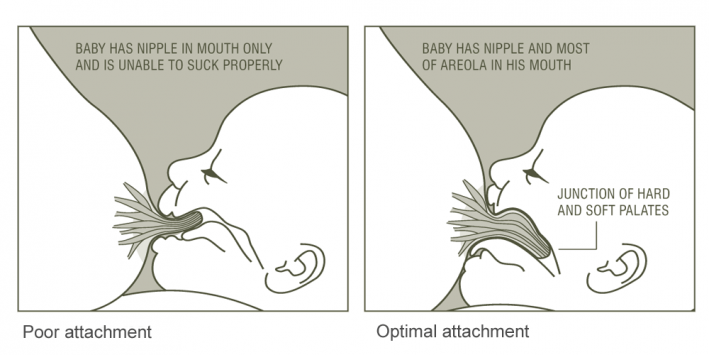The best way to learn to breastfeed is to have a midwife, lactation consultant or even another person who has breastfed, help you with your position and attaching the baby to your breast.
Your position
- Make sure you are sitting comfortably, and you are well supported.
- Hold your baby close to you, facing your chest.
- Position your baby on their side with their nose opposite your nipple.
- Support your breast from underneath.
- Position your fingers well back from the areola/nipple so your baby is able to take a big mouthful of breast tissue.
- Touch your baby’s lips with your nipple to encourage your baby to open their mouth wide.
- Make sure your baby's mouth is very wide (like yawning), bring your baby quickly to the breast, chin first.
- Attach so your baby's bottom lip is well down over the areola, 'off centre'.
- Continue to support your breast until your baby is sucking and swallowing in a deep rhythmic pattern.
- If you experience pain when your baby starts swallowing, take your baby off the nipple and re-attach.
- Remember to insert a clean finger between the baby’s gums to break the seal when taking your baby off the breast.

How often to feed
Your baby needs a minimum of seven to eight feeds in 24 hours, especially in the early weeks after birth.
You know your baby is feeding well when they:
- are settled after most feeds
- are alert, active and content when awake
- have at least six soaked cloth nappies in 24 hours after your milk 'comes in'; disposable nappies should be heavy and spongy
- have at least one yellow, loose bowel action every day after initial meconium (first bowel action) is passed.
Your baby should be back to birth weight by two weeks of age. Normal weight gain is between 20 and 30 grams per day, or between 150 and 210 grams per week.
You know your baby is feeding correctly when:
- after some initial short frequent sucks to stimulate milk flow, your baby begins to swallow. Sucking becomes slower, deeper, and more rhythmic with rest periods between each sucking burst. As the feed progresses the sucking bursts become shorter and the rest periods longer
- you can hear or see your baby swallowing.
You may develop problems breastfeeding if you:
- restrict suckling time at the breast
- give infant formula to your baby without medical advice
- use dummies in the early weeks.
Related information
- Maternal & Child Health Line 24 hours Helpline 13 22 29
- Australian Breastfeeding Association 24 hours Helpline 1800 686 268
- Australian Breastfeeding Association Breastfeeding videos in English and other languages
- Raising Children Network The Australian Parenting Website
- Provide feedback about the information on this page
Disclaimer
The Women’s does not accept any liability to any person for the information or advice (or use of such information or advice) which is provided on the Website or incorporated into it by reference. The Women’s provide this information on the understanding that all persons accessing it take responsibility for assessing its relevance and accuracy. Women are encouraged to discuss their health needs with a health practitioner. If you have concerns about your health, you should seek advice from your health care provider or if you require urgent care you should go to the nearest Emergency Dept.